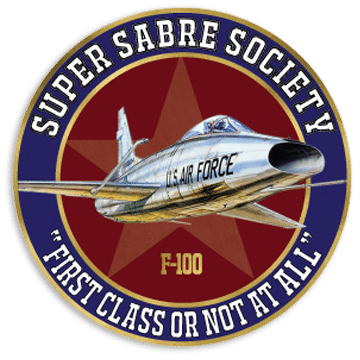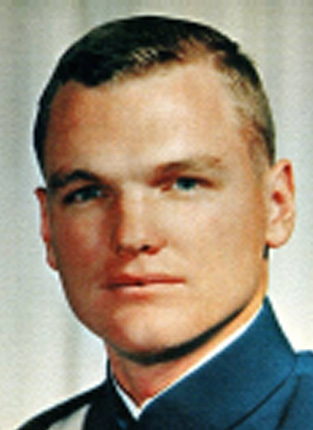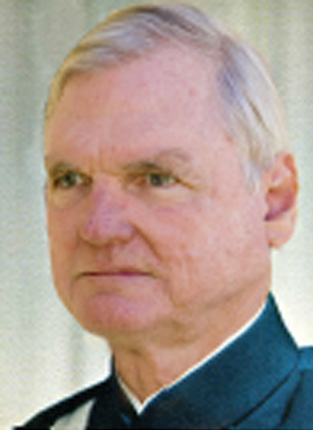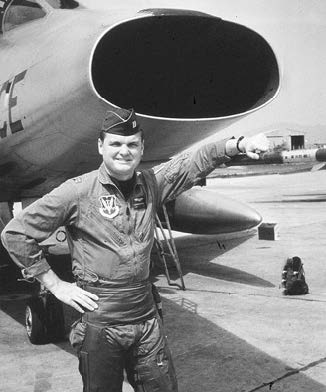“An undistinguished career in the Air Force, you bet. But how did it come to pass?
One day in 1955, my father learned that our local Congressman, Stephen B Deuronian of New York was giving a civil service exam to decide which ten people to nominate for the new Air Force Academy. I had a Navy R.O.T.C. scholarship and had no interest but my father prevailed. Fifty of us took the exam and ten were nominated and turned over to the Air Force for their selection process. Two or three days of tests at Mitchell Field on Long Island (now a shopping center) and I was in with another twenty-two or so from New York State.
Four endless years later I popped out and went to pilot training at Bartow Air Base, Florida, and Williams AFB, Arizona. Then to F-100’s at Luke AFB, Arizona with a polishing off at Nellis AFB, Nevada. Next, I went to Homestead AFB, Florida, arriving right in the middle of the Cuban Missile Crisis. I was not yet combat-ready, so my duties consisted of 12-hour shifts in the squadron command post.
If we went to war I would be in the back seat of one of the F-100F two-seat models and I have a distinct memory of being on the runway at Homestead with a war load bound for Cuba. It was a 300-foot wide runway and we were lined up eight abreast with 500 feet between each group of eight. The Wing Commander was in a command car and at the last minute called it off. It may have been an exercise but we all thought we were going for it.
Later while on rotation in Turkey (we had a squadron at Cigli AB Turkey with two or three airplanes on nuclear alert), I learned that the U.S. was to deploy Jupiter missiles to replace us but that President Kennedy had traded those for the Cuban missiles.
The 2000 movie “Thirteen Days” continues the Kennedy myth. In the movie, they said that the Jupiter missiles were traded but that they were obsolete and were to be replaced anyway. Obsolete! They hadn’t been installed yet. As I understood it, the Turks would let us bring whatever we wanted into the country but not out of the country (except for airplanes). There were acres of support equipment for the Jupiter’s rusting away in a yard on the base.
I can remember going with the squadron maintenance officer through boxes and boxes of equipment for fun just to see if there was anything the squadron might use. Flying around Turkey you could see the brand new, never used, launch pads in the hills. I saw 8X10 glossy photos of the missile hold-down equipment, which had been dynamited, and the pictures sent to Washington to verify their destruction. My take on the Cuban deal is that we were planning to replace the F-100 alert in Turkey with Jupiter Missiles. Khrushchev decided to deploy his missiles in Cuba. Big standoff, we caved and so did he. End of story.
By 1964 the Vietnam War was building up and there was an A-1 Skyraider program of a US pilot flying the old Navy prop plane with a Vietnamese observer. Classmate R.G. Head and I volunteered for the program and he was immediately accepted. I applied the next month and again was rejected. At my behest, the Wing Personnel guy called headquarters Tactical Air Command and was told to go to Viet Nam you had to qualify under the “Blue Ribbon Program”. I was rejected because my O.E.R.’s (Officer Effectiveness Reports) were not Very Fine Officer Upper Half (they were VFO Lower Half).
About the same time, I noticed that all of my contemporaries at Homestead had been PCS’d, most to F105’s. I had no “return date” despite months of overseas TDY’s (Japan, Korea, and Turkey) so I too should have been reassigned. I thought my 201 file might give me some answers so I went to Wing HQ and took a look. Under “Assignment Limitations” was “99G4”. I asked the Sergeant what that meant and he told me I was restricted from reassignment because I had been selected for a graduate degree. I had applied to A.F.I.T. (Air Force Institute of Technology) and received a letter that said I was to be considered for entry in 1967 but was NOT restricted from reassignment. A mere clerical error gave me the option to leave the Air Force.
I made the decision to get out based on the following:
At that time only 67% of first-time eligible Captains made Major (it subsequently became an automatic promotion).
There were some 125,000 officers in the air force but fewer than 300 General Officers. Realistically, what were my chances?
At best I could expect a 30-year career ending up Colonel at age 51.
I told everyone it was because they wouldn’t send me to Vietnam. That did start the process and it was ironic that one month after I got out, my entire squadron was sent to Vietnam for a year living in tents.
The highlight of my Air Force career was an inadvertent 12 ½ hour non-stop flight from Miami, Florida to Cigli Air Base, Turkey in a single-seat F-100. Inadvertent because I was “ground spare” and one guy’s afterburner blew out on takeoff, one airplane and its pilot were lost. Six air refuelings made it possible and we all were awarded the Air Medal.
I flew for Pan Am for 26 years, the last five as a Boeing 747 Captain, until they went out of business. Luckily I made a lateral transfer to Delta Air Lines, losing 4 years of seniority, and completed my career as an MD-11 Captain. I retired as an MD-11 (warmed-over DC-10) Captain. My retirement date is easy to remember 7/11, that’s right, two months before 9/11.
My forever-wife Susan and I live in Santa Barbara, CA, and have two grown daughters.
If you can’t be good, look good but most importantly, be lucky.”




